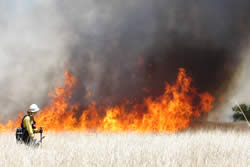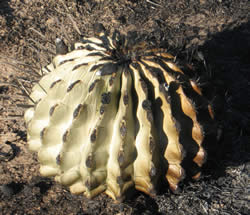
National Fire Plan Success Story
Buffelgrass Fire Behavior Research Burn
Saguaro National Park, Arizona
National Fire Plan - Firefighting
2008

Buffelgrass fire flame length can exceed 4 feet at almost any time of year, exceeding capability of hand tools. NPS photo.

Many desert species such as this barrel cactus are damaged or killed by fire. NPS photo.
Saguaro National Park teamed up with Tucson Water and the University of Arizona to conduct a 160-acre prescribed burn on City of Tucson land in Avra Valley on May 28, 2008 to learn more about how firefighters can safely control extremely hot, fast-moving fires fueled by buffelgrass, an invasive species. This project will also help land managers and property owners learn how to prevent or mitigate damage from buffelgrass fires.
The park planned and conducted the burn with support from Buenos Aires National Wildlife Refuge, Coronado National Forest, Northwest Fire District, and Tubac Fire District. Tucson Water provided substantial support as well, including staffing two water tenders and preparing fuel breaks. University of Arizona fire researchers used a variety of methods to document fuel loading and fire behavior.
Buffelgrass is a perennial noxious weed rapidly invading the Sonoran Desert. Crowding out native species, it is threatening to fuel larger, more frequent wildfires that threaten human lives and property. Impacts of buffelgrass fires on native plant and animal communities not adapted to fire are anticipated to be severe. Fuel loads can be 3-20 times greater than annual grasses like red brome. It is increasing rapidly; firefighters may find thick grass in places that traditionally had little, and since the fuel load is so heavy, it can generate fireline intensity and flame length much more extreme than usual for the desert. Strategies and tactics normally used on desert fires may not succeed on buffelgrass fires.
The area burned is part of a comprehensive research program being conducted by the University of Arizona and Tucson Water to determine the most effective and efficient methods for eliminating buffelgrass. Tucson Water’s Avra Valley property primarily consists of retired farmland purchased to acquire the associated water rights. Tucson Water manages the property with the intent to return the land to native vegetation.
Saguaro National Park, the City of Tucson, and numerous other entities are engaged in an on-going cooperative effort to reduce buffelgrass in Southern Arizona. Visit http://wwwpaztcn.wr.usgs.gov/buffelgrass/ or www.buffelgrass.org to learn more.
Contact: Perry Grissom, Fire Ecologist, (520) 733-5134.